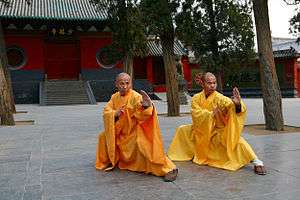Mizongyi
Mízōngyì (Chinese: 迷蹤藝; lit.: 'Lost Track Skill'), or simply Mízōng, is a style of Chinese martial art based on deception and mobility. Mizong is also known as Mízōngquán (Chinese: 迷蹤拳; lit.: 'Lost Track Fist' or sometimes "Labyrinthine Boxing" stressing the deceptive nature of the art) and Yànqīngquán (Chinese: 燕青拳; lit.: 'Blue Swallow Fist'). There are many sub-branches of this style.
| Also known as | Lost Track Skill, Lost Track Fist / Mizongquan (迷蹤拳), Lost Track Fist / My Jong Law Horn (迷蹤羅漢拳) / Mizong Luohan |
|---|---|
| Focus | Striking |
| Country of origin | China |
| Creator | Yue Fei (attributed) |
| Famous practitioners | Huo Endi Huo Yuanjia Cheng Juxiao Ye Yu Ting Chi-Hung Marr Johnny Kwong Ming Lee Henry Su John Su James “Jimbo” Carinio |
| Parenthood | Northern Chinese martial arts, Northern Shaolin Kung Fu |
| Descendant arts | Mizong Lohan |
| Olympic sport | No |
| Part of a series on |
| Chinese martial arts (Wushu) |
|---|
 |
| Wushu in the world |
|
Historical locations
|
| Wushu athletes/practitioners |
|
Legendary figures
|
|
Historical individuals
|
|
Modern celebrities
|
| Wushu influence |
Mizong Lohan (Chinese: 迷蹤羅漢; pinyin: mízōng luóhàn; lit.: 'Lost Track Arhat') is a combination of two styles: Mízōngquán and Luóhànquán. Through Luóhànquán, its lineage can be traced back to the Shaolin temple during the time of the Tang Dynasty (618–907).
As an external northern Chinese style, Mizong belongs to the "Long Fist" family of martial arts although in some traditions Mizong is considered an internal art, created by Yue Fei, and taught as a precursor system to Hsing I Ch'uan. Mizongquan was created by Cheng Juxiao. Cheng learned from his maternal grandfather and mother; of which both were also practitioners of Mizongyi.[1]
The art began to grow popular since 1901 due to the deeds of Huo Yuanjia, a Mizongyi master.[2] Huo Yuanjia's father, Huo Endi is a 6th-generation successor of Mizongyi.[3]
Description
Mi Zong Luo Han is an external style, with distinct internal influences. It draws on many aspects of the external Northern Shaolin long-fist style, and the internal styles T'ai chi ch'uan and Baguazhang, which are often taught alongside it in modern times. It is characterized by deceptive hand movements, intricate footwork, varied kicks, and high leaps. The style changes very quickly when executed.
The emphasis on flexibility in Northern Shaolin Kung Fu styles is the guiding principle of Mi Zong, and this is evident in the versatility of its attacks and the extent to which it integrates core concepts of multiple internal styles. An increased emphasis on mobility often comes at the cost of power, but Mi Zong kungfu compensates for this by providing a way for a dynamic generation of power. Mi Zong's unique Fa Jing, discharging explosive power like lightning strikes, comes from the combination of the internal corkscrew power of Hsing I, Chen-style Tai Chi and the external snapping power of Shaolin Long Fist. The result is an efficient production of power through a dynamic motion of multiple elements of the body, the mastery of which gives a Mi Zong's practitioner the capability of generating quick and flexible force from any distance. In short, F=ma and a= the acceleration of Mizong's fists and kicks is high at the moment of impact which gives rise to strong force and hence high power.
Mizong Luohan's system was presided over by Grandmaster Ye Yu Ting in the twentieth century until his death in 1962, at the age of 70. A number of his students such as Masters Chi-Hung Marr, Raymond K. Wong, and Johnny Lee emigrated to North America in the 1960s and have continued to teach this system in various locations around the United States of America, from Los Angeles, Dallas Texas, Coppell Texas, to Hawai`i, and Canada.[4]
Mizong Chuan has also been continued to be taught as a foundation art to Hsing I/Xing Yi within the Yue Jia Ba Shao/Geng Jishan tradition in London, England. Within this tradition, Mizong was primarily taught to children as, from a learning perspective, the technical, internal aspects of the art are less sophisticated (i.e., more external) than in Hsing I.
See also
References
- Shou-Yu Liang & Wen-Ching Wu (2001). Kung Fu Elements: Wushu Training and Martial Arts Application Manual. Way of the Dragon Publishing. ISBN 1-889659-17-7.
- Chris Crudelli (2008). The Way of the Warrior. Dorling Kindersley Ltd. ISBN 1-4053-3750-8.
- 冯骥才, 张仲 (2004). 记忆天津: 2004 : 天津建城600年. 浙江摄影出版社.
- "The Legend". Tang Martial Arts Center. Retrieved 2016-10-07.